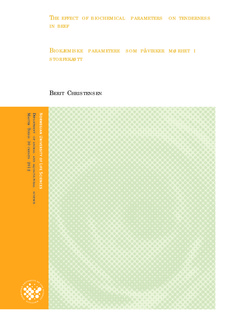| dc.contributor.author | Christensen, Berit | |
| dc.date.accessioned | 2012-09-06T09:32:36Z | |
| dc.date.available | 2012-09-06T09:32:36Z | |
| dc.date.copyright | 2012 | |
| dc.date.issued | 2012-09-06 | |
| dc.identifier.uri | http://hdl.handle.net/11250/186137 | |
| dc.description.abstract | The tenderness of beef is determined by the degree of myofibrillar toughness and content of insoluble collagen. The myofibrils and connective tissue and their degradation is largely determined by the amount of proteases in the muscle. These includes, respectively, of calpains and metalloproteinases. The design of the experiment makes it possible to study the relative importance of myofibrils and the connective tissues role in tenderness of beef, one topic yet to be resolved in meat science.
The samples were withdrawn from 550 NRF bulls from 25 elite sires in a period from fall 2008 to winter 2012 and slaughtered at Nortura Rudshøgda. The samples analyzed in this thesis were selected on the basis of their values from Warner- Bratzler’s tenderness measurements. Preliminary heritability (h2) of Warner-Bratzler was calculated to be about 0.35 and means that there is a significant variation between the tenderness of the families.
The hydroxyproline content, intramuscular fat and calpain activity was in general more or less the same for all of the samples. The one parameter that stood out was MMP-2 and the greater activity in the group “tender with low standard deviation”. | no_NO |
| dc.language.iso | eng | no_NO |
| dc.publisher | Norwegian University of Life Sciences, Ås | |
| dc.subject | MMP-2 | no_NO |
| dc.subject | tenderness | no_NO |
| dc.title | The effect of biochemical parameters on tenderness in beef | no_NO |
| dc.title.alternative | Biokjemiske parametere som påvirker mørhet i storfekjøtt | no_NO |
| dc.type | Master thesis | no_NO |
| dc.subject.nsi | VDP::Technology: 500::Food science and technology: 600 | no_NO |
| dc.source.pagenumber | 37 | no_NO |
